【免费下载】初中英语教学设计模板教案设计
初中英语教案设计模板全英文版(共8篇)
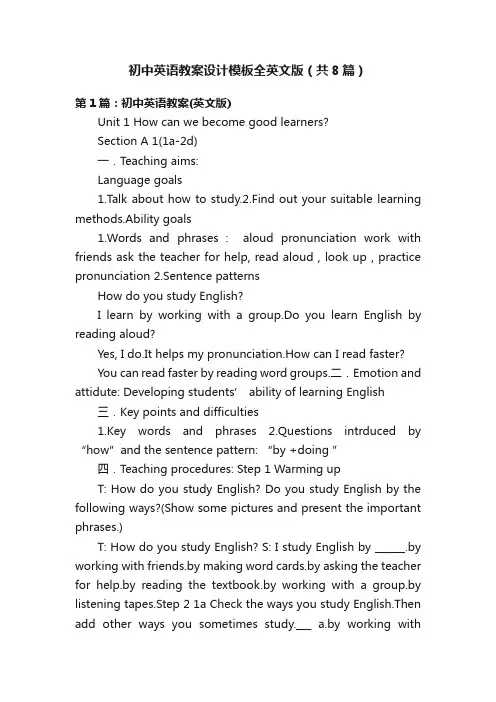
初中英语教案设计模板全英文版(共8篇)第1篇:初中英语教案(英文版)Unit 1 How can we become good learners?Section A 1(1a-2d)一.Teaching aims:Language goals1.Talk about how to study.2.Find out your suitable learning methods.Ability goals1.Words and phrases:aloud pronunciation work with friends ask the teacher for help, read aloud , look up , practice pronunciation2.Sentence patternsHow do you study English?I learn by working with a group.Do you learn English by reading aloud?Yes, I do.It helps my pronunciation.How can I read faster?You can read faster by reading word groups.二.Emotion and attidute: Developing students’ ability of learning English 三.Key points and difficulties1.Key words and phrases2.Questions intrduced by “how”and the sentence pattern: “by +doing ”四.Teaching procedures: Step 1 Warming upT: How do you study English? Do you study English by the following ways?(Show some pictures and present the important phrases.)T: How do you study English? S: I study English by ______.by working with friends.by making word cards.by asking the teacher for help.by reading the textbook.by working with a group.by listening tapes.Step 2 1a Check the ways you study English.Then add other ways you sometimes study.___ a.by working withfriends.___ b.by making word card.___ c.by reading the textbook.___ d.by listening to tapes ___ e.by asking the teacher for help.…Step 3 Listening1)Listen.How do these students study for a test? Write letters from 1a above.2)Check the answers: b(Meiping);e(Peter);d(Tony)Step 4 Gue Show some pictures.Gue: How does he/she study English? He/She studies English by…How do they study English? They study English by… Step 5 Pairwork1c Make conversations about how you study for a test.A: How do you study for a test?B: I study by working with a group.A: How do you study for a test?B: I study by… Step 6 Listening2a Listen and check the questions you hear.1 ____ Does anyone learn English by watching videos? 2 ____ Do you have conversations with friends in English? 3 ____ What about listening to tapes? 4 ____ What about reading aloud to practice pronunciation? 5 ____ Have you ever studied with a group?Answers: 1, 2, 4, 5 2b Listen again.Match each answer below with a question above.a.Yes, I have.I’ve learned a lot that way.b.Oh, yes.It really improves my speaking skills.c.I do that sometimes.I think it helps.d.No.It’s too hard to understand spoken English.Answers: d, b, c, a Step 7 Pairwork 1.2c Make conversations using the information in 2a and 2bA: Have you ever studied with a group?B: Yes, I have.I’ve learned a lot that way.Show some pictures.1)A: Do you learn English by watching movies?B: Yes, it’s a very interesting way.C: No, it’s too hard tounderstand spoken English.2)A: What about writing letters to a pen pal in America?B: Yes, it helps to improve my writing skills and know a lot aboutAmerica.3)A: Do you have conversations with friends in English?B: Of course, we can talk about plenty of things like school, pets,movies, and our parents.Step 8 SummaryHow do you study English?1.by working with friends2.by watching English movies.3.by making word cards.4.by reading the textbook.5.by listening to tapes.6.by asking the teacher for help.7.by reading aloud.Step9 Homework How do you study English? What about physics and Chinese? Make a list.第2篇:初中英语说课稿获奖全英文版Oral Presentation of Leon Plan for Unit 12 My favorite subject is science Go for it Grade 7(注:本说课稿根据“2007年首届全国中学英语教师教学基本功大赛暨教学观摩研讨会(初中)”)[Presenting the 1st PPT about the introduction.] Well, good afternoon ladies and gentlemen, I am very happy to meet you all here.Today,I am going to present Unit 12 Writing.Well, please look at the teaching material together.Well, this is a letter in the book.Students are required to read it through, have a look at it, try to write a letter to Zhao Jie, a boy who doesn’t like any subjects at all.[Presenting the 2nd PPT about the given letter.] Well, I think my teaching aims should include the proper form of English letter, and second, how to write a letter in an idiomatic way.[Presenting the 3rd PPT about the teaching aims.]Well, to achieve these goals, I am going to arrange myteaching step by step [Presenting the 4th PPT about the teaching procedures].Well, these are the steps, since so many, let me make it simple, actually, they are words, sentences and paragraphs.As we know that articles consist of words and sentences.So first, I would like to talk about the words.That is also the first step---revision.Well, you know, students have learned the names of the subjects in the former leons.So, I am going to review the words by playing games with them.Here comes the first game: who can write more? [Presenting the 5th PPT about the 1st game]I am going to divide the students into two groups, for example boys and girls.They are given two minutes to rush to the blackboard and write down the subjects they know.The group which can write more will be the winner.Imagine how excited the students are, and at the same time, they are also reviewing the words.Well, what’s more, you may have noticed these two subjects, Physics and Chemistry.[Presenting the 6th PPT about the result of the game] Actually, these two subjects are not in this book.So, in this way, we can know that some students are showing us how much they know and all the students can also enlarge their vocabulary at the same time.Well, after words, I would like to turn to sentences.Here comes the second game, who can make it longer? [Presenting the 7th PPT about the 2nd game] I am going to give students a word, for example subject.Which students can make it longer? Well, you please.Favorite subject.Good.A phrase appears.Longer? You please.My favorite subject is English.Well, a sentence appears.Even longer? My favorite subject is English, I like it very much, it is so interesting.[Presenting the 8th PPT about the answers of the game]Well, you can see students are constructing words into sentences step by step.Well, this is the revision part.After that, it is time to read.From now, I am going toshow students the given material so soon.Actually, instead, I am going to show them those separated pieces.They should put them into the correct order[Presenting the 9th PPT about the reordering task].You know before the leon, I divided the whole letter into these four parts, why do I bother to do this? Well, you can see, in this way, students can put more attention to how to begin and how to end a letter.Then, they have a time, can have a chance to read through the whole article[Presenting the 10 th PPT about the reading material].Well, at the same time, they should also pick out those well used words and sentences, and share them with the whole cla.Then, they have a discuion “what information can we use? [Presenting the 11th PPT about the discuion task]Why talking about subjects? Of course, it is easy for them to find these information like these three ones(time & day, teacher, reason), because they are in the letter.But what else? Students need to think about that.Well, why? As we know it is easy to copy, but difficult to create.Sometimes, the given material gives us a good example, but sometimes, they may also limit students’ ideas.So they need to go further.As some teachers may prefer to offer the answers directly to the students.But I am not.I think teaching students how to learn is much more important than just teaching knowledge.So students should think about that by themselves.Well, this part is also a brainstorm to them.Till now, they have known so much.Since that, they should be given a chance to put wha t they’ve known into practice.So I prepare two practices[Presenting the 12th PPT about the 2 practices].Practice number one, students have a Free Talk about their favorite subjects, if they can expre themselves fluently and naturally, they won’t have much difficulty in writing them down.Well, second practice will be the real writing.They aregiven eight minutes to write a letter to Zhao Jie[Presenting the 13th PPT about the beginning of the letter].Well, when they finish writing, six students get into a group, they exchange their letters and try to correct mistakes.Why they should do that? Well, teachers may have noticed that not many students have the habit of rewriting and correcting mistakes when they finish writing, and I want them to realize this is also very important.Ok, after that, each group chooses two representatives, the best one and the one who has made great progre.Which two? I think not only those advanced students but also the le advanced students should be given a chance to show how good they are.Well, for example, yes, after that, some representative come to the front and show their letters to the whole cla, but you can think it is a projector like this.This is a student’s letter and when all students finish writing it, they are welcomed to give comments.It is so-so, good or great.So which one? Can you find any beautifull sentences here? They are welcomed to give their ideas.Well, here comes the last part[Presenting the 14th PPT about the homework].Last part will be the homework.They can either write me an email or have a talk with some one or write an article about his or her favorite ********.I think both of these are highly connected with our daily life.So, students must be very interested.Ok, so that is all.Thank you very much!(答辩问答)Questions:Anyhow, I appreciate your teaching, and allow me to say so.My question is “ how do you check the achievements of the homework you send to your pupils?Answer:Well, about this question, I think, first, still the group work.They should exchange their letters and each group should also choose two representatives and hand in the letters or the articles they have written to me, and I correct them bymyself.And then, put all these representatives’ works on the wall and show them to the whole cla.By this way.Thank you!第3篇:全英初中英语教案鲁人办发[2008]78号关于做好2008年省内高校特困家庭毕业生求职补贴发放工作的通知各高等学校:按照山东省人民政府办公厅《关于做好特困家庭高校毕业生就业工作的通知》(鲁政办发[2008]21号)要求,现就做好2008年省内高校特困家庭毕业生求职补贴发放工作有关事项通知如下:一、发放范围求职补贴发放范围为符合城乡低保、零就业家庭、农村贫困家庭等特殊情况,就业有困难需要帮助的2008年省内高校山东生源应届毕业生(以下简称特困生)。
初中英语优秀教学设计模板(精选6篇)
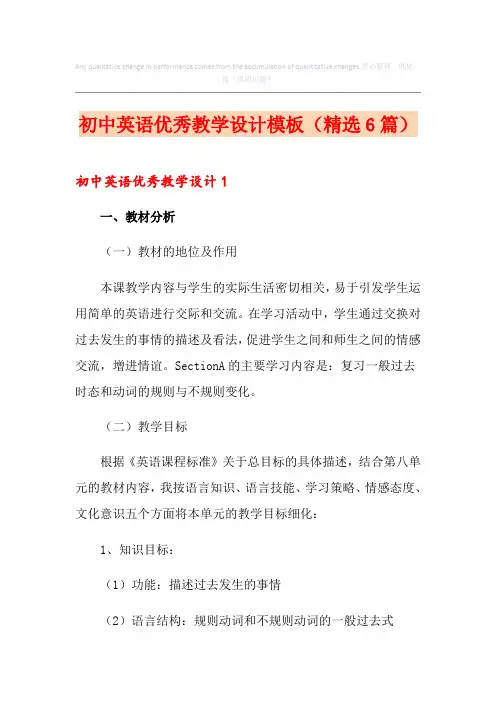
Any qualitative change in performance comes from the accumulation of quantitative changes.悉心整理助您一臂(页眉可删)初中英语优秀教学设计模板(精选6篇)初中英语优秀教学设计1一、教材分析(一)教材的地位及作用本课教学内容与学生的实际生活密切相关,易于引发学生运用简单的英语进行交际和交流。
在学习活动中,学生通过交换对过去发生的事情的描述及看法,促进学生之间和师生之间的情感交流,增进情谊。
SectionA的主要学习内容是:复习一般过去时态和动词的规则与不规则变化。
(二)教学目标根据《英语课程标准》关于总目标的具体描述,结合第八单元的教材内容,我按语言知识、语言技能、学习策略、情感态度、文化意识五个方面将本单元的教学目标细化:1、知识目标:(1)功能:描述过去发生的事情(2)语言结构:规则动词和不规则动词的一般过去式(3)一般过去时的一般疑问句句型:Did you go to the zoo?Yes, I did、 No, I didn’t、 I went to the aquarium、Were there any seals? Yes, there were、 No, there weren’t any sharks、I saw somesharps/ I went to the aquarium、2、语言技能:听:能识别不同句式的语调,并能根据语调变化,判断句子意义的变化。
能听懂本课学习活动中的问题,做出较得体的回答。
(1)说:能在本课的任务型活动如:游戏、调查、故事接龙等中进行简单有交流。
(2)读:能正确朗读本单元对话和句型。
能查阅工具书为完成任务做准备。
(3)写:能写出本节课学习的单词和句型,能运用简单的句子写出过去的活动和感受。
3、学习策略:抓住用英语交际的机会,在交际中把注意力集中在意思的表达上,必要时借助手势和表情。
初中英语教案(优秀7篇)
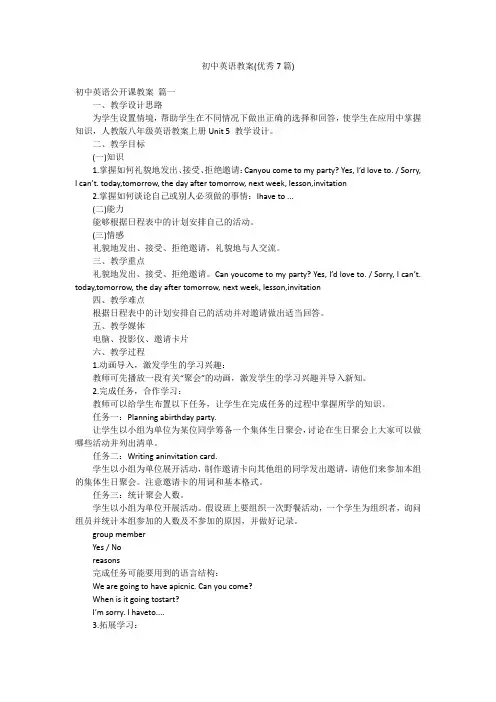
初中英语教案(优秀7篇)初中英语公开课教案篇一一、教学设计思路为学生设置情境,帮助学生在不同情况下做出正确的选择和回答,使学生在应用中掌握知识,人教版八年级英语教案上册Unit 5 教学设计。
二、教学目标(一)知识1.掌握如何礼貌地发出、接受、拒绝邀请:Canyou come to my party? Yes, I’d love to. / Sorry,I can’t. today,tomorrow, the day after tomorrow, next week, lesson,invitation2.掌握如何谈论自己或别人必须做的事情:Ihave to ...(二)能力能够根据日程表中的计划安排自己的活动。
(三)情感礼貌地发出、接受、拒绝邀请,礼貌地与人交流。
三、教学重点礼貌地发出、接受、拒绝邀请。
Can youcome to my party? Yes, I’d love to. / Sorry, I can’t. today,tomorrow, the day after tomorrow, next week, lesson,invitation四、教学难点根据日程表中的计划安排自己的活动并对邀请做出适当回答。
五、教学媒体电脑、投影仪、邀请卡片六、教学过程1.动画导入,激发学生的学习兴趣:教师可先播放一段有关“聚会”的动画,激发学生的学习兴趣并导入新知。
2.完成任务,合作学习:教师可以给学生布置以下任务,让学生在完成任务的过程中掌握所学的知识。
任务一:Planning abirthday party.让学生以小组为单位为某位同学筹备一个集体生日聚会,讨论在生日聚会上大家可以做哪些活动并列出清单。
任务二:Writing aninvitation card.学生以小组为单位展开活动,制作邀请卡向其他组的同学发出邀请,请他们来参加本组的集体生日聚会。
注意邀请卡的用词和基本格式。
任务三:统计聚会人数。
版初中英语教案全英文【8篇】
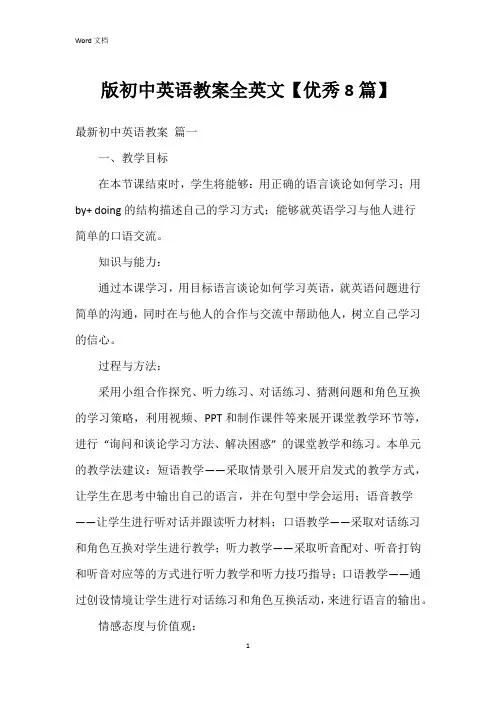
版初中英语教案全英文【优秀8篇】最新初中英语教案篇一一、教学目标在本节课结束时,学生将能够:用正确的语言谈论如何学习;用by+ doing的结构描述自己的学习方式;能够就英语学习与他人进行简单的口语交流。
知识与能力:通过本课学习,用目标语言谈论如何学习英语,就英语问题进行简单的沟通,同时在与他人的合作与交流中帮助他人,树立自己学习的信心。
过程与方法:采用小组合作探究、听力练习、对话练习、猜测问题和角色互换的学习策略,利用视频、PPT和制作课件等来展开课堂教学环节等,进行“询问和谈论学习方法、解决困惑” 的课堂教学和练习。
本单元的教学法建议:短语教学——采取情景引入展开启发式的教学方式,让学生在思考中输出自己的语言,并在句型中学会运用;语音教学——让学生进行听对话并跟读听力材料;口语教学——采取对话练习和角色互换对学生进行教学;听力教学——采取听音配对、听音打钩和听音对应等的方式进行听力教学和听力技巧指导;口语教学——通过创设情境让学生进行对话练习和角色互换活动,来进行语言的输出。
情感态度与价值观:通过参与课题教学活动,增进同学之间的了解和友情,并在交流中了解英语学习的方法,建立学习英语的自信。
二、教学重难点教学重点:学习并掌握How do you study...? I study...by ....等相关句型和词汇。
学习并掌握用by + doing 结构表达方式方法。
教学难点:学习并用丰富的语言描述英语学习的方式和方法。
三、教学策略短语教学——采取视频引入话题然后进行启发式教学,并在对话中运用;语音教学——让学生跟读听力材料进行模仿式操练;口语教学——采取pair work 和Role- play问答式的口语交际活动或小组活动互相操练;听力教学——采取采取听音配对、听音打钩和听音对应等方式语法教学——通过模仿听力材料进行对话练习,在教师的纠正中培养正确的by + doing 的结构意识。
初中英语公开课教案篇二课前准备教师:准备游戏时所用的图片(食物、蔬菜、动物)。
初中英语的优秀教学设计【4篇】
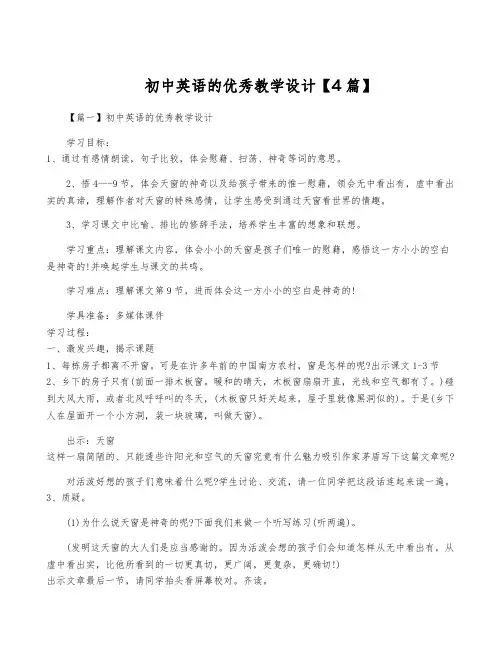
初中英语的优秀教学设计【4篇】【篇一】初中英语的优秀教学设计学习目标:1、通过有感情朗读,句子比较,体会慰藉、扫荡、神奇等词的意思。
2、悟4---9节,体会天窗的神奇以及给孩子带来的惟一慰藉,领会无中看出有,虚中看出实的真谛,理解作者对天窗的特殊感情,让学生感受到通过天窗看世界的情趣。
3、学习课文中比喻、排比的修辞手法,培养学生丰富的想象和联想。
学习重点:理解课文内容,体会小小的天窗是孩子们唯一的慰藉,感悟这一方小小的空白是神奇的!并唤起学生与课文的共鸣。
学习难点:理解课文第9节,进而体会这一方小小的空白是神奇的!学具准备:多媒体课件学习过程:一、激发兴趣,揭示课题1、每栋房子都离不开窗。
可是在许多年前的中国南方农村,窗是怎样的呢?出示课文1-3节2、乡下的房子只有(前面一排木板窗。
暖和的晴天,木板窗扇扇开直,光线和空气都有了。
)碰到大风大雨,或者北风呼呼叫的冬天,(木板窗只好关起来,屋子里就像黑洞似的)。
于是(乡下人在屋面开一个小方洞,装一块玻璃,叫做天窗)。
出示:天窗这样一扇简陋的、只能透些许阳光和空气的天窗究竟有什么魅力吸引作家茅盾写下这篇文章呢?对活泼好想的孩子们意味着什么呢?学生讨论、交流,请一位同学把这段话连起来读一遍。
3、质疑。
(1)为什么说天窗是神奇的呢?下面我们来做一个听写练习(听两遍)。
(发明这天窗的大人们是应当感谢的。
因为活泼会想的孩子们会知道怎样从无中看出有,从虚中看出实,比他所看到的一切更真切,更广阔,更复杂,更确切!)出示文章最后一节,请同学抬头看屏幕校对。
齐读。
(2)你们是不是觉得这段话很难理解?有什么问题吗?估计学生提出的问题有:①天窗、有、无、虚、实、为什么要加引号?②为什么说活泼会想的孩子会从无中看出有,从虚中看出实?③为什么说比他所看到的一切更真切,更广阔,更复杂,更确切?同学们的问题提得很好,弄懂了这些问题,也就是真正理解了这篇课文。
(出示学习目标、齐读)下面我们就来认真读课文,请大家自读课文4--7节。
最新初中英语教案英文版(优秀四篇)
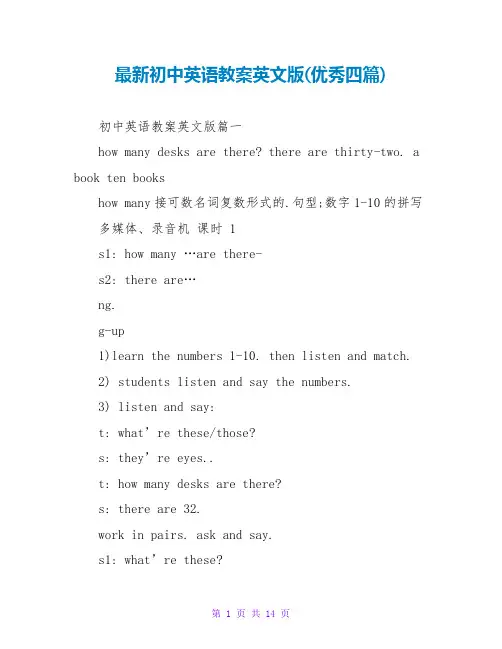
最新初中英语教案英文版(优秀四篇)初中英语教案英文版篇一how many desks are there? there are thirty-two. a book ten bookshow many接可数名词复数形式的.句型;数字1-10的拼写多媒体、录音机课时 1s1: how many …are there-s2: there are…ng.g-up1)learn the numbers 1-10. then listen and match.2) students listen and say the numbers.3) listen and say:t: what’re these/those?s: they’re eyes..t: how many desks are there?s: there are 32.work in pairs. ask and say.s1: what’re these?1) write the numbers.2) look at the pictures and write the phrases.derkwork book.个人修改初中英语教案英文版篇二starter module3 unit1 课型 listeningandspeaking学习询问颜色句型what colour are …? they are red. how do you spell “red”? r-e-d.颜色词汇的拼写记忆多媒体、录音机课时 1ng.g-up1)look and learn theword:apple,banana,flower,tree,bird,cat2) look at the pictures and the colour words.3) listen and say:t: what colour are they?t: how do you spell “red”?s: r-e-d..work in pairs. ask and say.s1: what colour are they?s2: they’re….s1: how do you spell it?s2: …se1) read and match.2) look at the pictures and write the sentences.derkwork book.初中英语教案英文版篇三sectiona 1a-2d一、教学目的〔一〕知识与技能:1. 学习并掌握1a-2d的单词和短语(1) rainstorm, alarm, begin ,heavily ,suddenly, strange;(2)go off, pick up, take a shower, make sure;2. 掌握并运用句型(1)what were you doing yesterday at the time of the rainstorm?(2)when you called, i was having a shower.(3)so while you were sleeping, i called jenny and she helped me.(4)what were you doing when the rainstorm came?3.掌握过去进展时态的构造和功能,学会使用when和while从句。
初中英语教师教学教案设计(7篇)
初中英语教师教学教案设计(7篇)学校英语老师教学教案设计(7篇)17世纪以来,在英美两国的广泛影响下,现代英语已经在全世界传播开来。
如今已成为世界领先语言之一,以下是我预备的学校英语老师教学教案设计范文,欢迎借鉴参考。
学校英语老师教学教案设计(精选篇5)学校英语老师教学教案设计(精选篇6)一、教学内容请描述一下你的朋友,看看他(她)过去和现在有什么变化,请从外貌、性格、爱好来说明。
词数:80~100左右。
二、教学目标1、能用英语简洁描述自己或他人过去和现在发生变化。
2、以小组争论的方式起草和修改作文。
三、教学方法小组争论、小组合作、竞赛、练习等四、教学步骤1、复习词组和句子:通过小组竞赛和俩俩对话复习谈论某人过去和现在发生变化表达。
为同学写作做铺垫。
如:used to do sth。
play basketballplay soccerplay the pianoplay the violinenjoy doing sth。
prefer doing sth.be interested in doing sth。
climb the hillgo swimminglike doing sth。
all the timecollectstampsMy hobbies are changing all the time.2、仔细审题,明确题意:老师介绍用第几人称、用什么时态、简述写作方法,提出字数要求等。
3、小组争论,具体构思:由小组成员争论有关话题,如先让同学相互介绍自己有什么变化。
然后再进行沟通观点,老师可以参加小组争论补充有关信息等,以便进一步完善或拓展其写作思路。
4、仔细独立完成作文:通过沟通和探讨,每个同学仔细编写提纲、打草稿,在这个过程中,有问题可求助于组员或老师,但不能抄袭他人作品。
完成后仔细阅读,老师引导同学自己修改。
同时老师可以供应一些精彩句子,为同学写作供应素材。
5、小组成员互评互改:老师简要传授修改策略,同桌相互阅读作品,并做必要的修改,并用红笔划出好词、好句。
初中英语教学设计通用模版教案
初中英语教学设计通用模版教案一、教学内容本节课选自《牛津初中英语》第5册,具体内容包括第2单元“Life in the future”的Part A部分。
详细内容包括对未来的生活进行探讨,学习相关的词汇和语法结构,如一般将来时态,以及通过阅读理解和听力练习,提高学生对未来科技发展的认知。
二、教学目标1. 知识与技能:掌握本课的生词和短语,并能运用一般将来时态描述未来生活。
2. 过程与方法:通过小组合作,提高学生的听说能力和阅读理解能力。
3. 情感态度与价值观:激发学生对未来生活的想象力和创新意识,培养他们积极向上的生活态度。
三、教学难点与重点教学难点:一般将来时态的运用和未来生活场景的描述。
教学重点:掌握生词、短语和一般将来时态的语法结构。
四、教具与学具准备1. 教具:多媒体设备、黑板、教学挂图等。
2. 学具:课本、练习册、词汇卡片等。
五、教学过程1. 导入:通过展示一幅未来城市的图片,引发学生对未来生活的思考,进而导入新课。
2. 新课内容展示:讲解生词、短语,分析课文,学习一般将来时态。
3. 例题讲解:以课文中的句子为例,讲解一般将来时态的构成和用法。
4. 随堂练习:让学生运用一般将来时态,描述未来生活中的一个场景。
5. 小组活动:分组讨论,每组选择一个未来科技话题,进行角色扮演,展示成果。
六、板书设计1. Life in the Future2. 内容:语法:一般将来时态(will + 动词原形)七、作业设计1. 作业题目:请运用一般将来时态,描述你理想中的未来生活。
八、课后反思及拓展延伸1. 反思:本节课学生的参与度较高,但对一般将来时态的掌握程度还需加强。
在今后的教学中,应多设计相关练习,提高学生的运用能力。
2. 拓展延伸:让学生课后关注科技新闻,了解最新的科技发展动态,为下一节课做准备。
重点和难点解析1. 教学难点与重点的确定。
2. 教学过程中的例题讲解和随堂练习设计。
3. 板书设计的内容布局。
七年级英语教学设计详细教案(精选7篇)
七年级英语教学设计详细教案(精选7篇)初一英语教案篇一【课题】Unit1 My name’s Gina.【学习目标】知识与能力:1、掌握并规范字母Ii-Rr.2、识记本单元词汇:what, this, in, English, a, an, map, orange, jacket, key, quilt, pen, ruler, spell, please, etc.过程与方法:学会从对话中获取对方的相关信息。
情感态度与价值观:使学生学会如何礼貌的与他人交往。
【学习重难点】:熟练掌握本单元词汇及语言结构。
一、自主预习【预习任务】:任务一:写出下列汉语的英语形式。
名字xx遇见xx问题,难题xx 回答,答案xx第一的x 最后的xx任务二:写出下列单词的汉语意思。
1、my2、clock3、nice4、what5、your6、hello7、I8、you9、his10、her11、name12、are一三、is【预习诊断】:1、选择题:(1)Kate has lost(丢失) _________key、_________asked _________for help、A、her ,he, IB、his, he ,meC、his, she, ID、her, she, me(2)_________plus(加) seven is thirteen?A、FiveB、SixC、EightD、Nine(3)_________is her name?A、whoB、what C where D、How2、写出下列英语形式。
(1):电话号码?_________(2):早晨好_________(3):下午好_________3、写出下列词的英语意思:1)、早晨_________2)、下午_________3)、晚上_________4)、谢谢_________5)、名字_________6)、好的_________or_________【预习反思】:你还有什么问题吗?(Do you have any problems?)二、课中实施Step1 交流展示Step2 精讲点拨:What’s your name?你叫什么名字?句中的your可根据问对象换成his、her等物主代词。
初中英文教学设计模板(精选5篇)
初中英⽂教学设计模板(精选5篇) 作为⼀位⽆私奉献的⼈民教师,时常需要编写教学设计,借助教学设计可以提⾼教学质量,收到预期的教学效果。
你知道什么样的教学设计才能切实有效地帮助到我们吗?以下是店铺精⼼整理的初中英⽂教学设计模板,欢迎⼤家借鉴与参考,希望对⼤家有所帮助。
初中英⽂教学设计篇1 教学⽬标: 1、能听懂、会说、会读、会拼写词汇look for, join, study 2、能听懂、会说、会读⽇常交际⽤语和句型Classes are over. Perhaps they are. I’ll go and join them. Where are you going? I’m going to … 3、培养学⽣乐于助⼈的良好思想品质。
重点难点: 1、四会掌握词汇和句型。
2、能正确理解掌握并运⽤⽇常交际⽤语。
教学过程: ⾸先是准备环节。
在这⼀环节,⽼师与学⽣交谈彼此的爱好,在轻松愉快的氛围中,拉近⽼师与学⽣之间的距离,为新授课的学习打下良好的铺垫。
其次是复习兼新授(单词与句型的学习)环节。
这⼀环节包括两个步骤,⼀通过看动画图⽚来复习“现在进⾏时”的特殊疑问句,帮助学⽣进⼊这⼀时态的学习⽽做好准备。
⼆以“猜猜看”的游戏来帮助学⽣重温了“现在进⾏时”的⼀般疑问句,在这个过程中引出新单词和句型的学习并进⾏相应的操练,提前把课⽂中的难点解决掉,为下⾯的课⽂学习扫除障碍。
接着是课⽂学习环节。
通过观看课⽂动画⽚,让学⽣做相应的练习来理解和学习朗读课⽂。
然后是巩固环节。
这个环节分三步,第⼀步是以不同的⽅式来让学⽣熟读课⽂。
第⼆步是训练培养学⽣听的能⼒,完成练习“Listen and match”。
第三步是训练培养学⽣写的能⼒,完成练习“Look, read and complete”。
初中英⽂教学设计篇2 ⼀、教学⽬标: 1. 语⾔知识⽬标: 1) 能掌握以下单词: rain, windy, cloudy, sunny, snow, weather, cook, bad, park,message, take a message, could, back, problem 能掌握以下句型: ① —How's the weather in Beijing? —It's sunny. ② —Can I take a message for him? —Yes. Could you just tell him to call me back? —Sure, no problem. 2) 能⽤所学的知识描述天⽓情况。
- 1、下载文档前请自行甄别文档内容的完整性,平台不提供额外的编辑、内容补充、找答案等附加服务。
- 2、"仅部分预览"的文档,不可在线预览部分如存在完整性等问题,可反馈申请退款(可完整预览的文档不适用该条件!)。
- 3、如文档侵犯您的权益,请联系客服反馈,我们会尽快为您处理(人工客服工作时间:9:00-18:30)。
初中英语教学设计模板教案设计 Food and drink 教学内容分析饮食话题是学生们最感兴趣的话题之一。
他与人们的日常生活息息相关。
只要老师引导得好,可设计许多的内容。
同时“饮食”话题也是初中阶段必会的以及各类考试中经常涉及的重要话题之一。
本单元主要让学生练习“吃”和“喝”的话题。
结合时间的表达和“饿了”“渴了”的表达引出“想吃什么”,“想喝什么”的话题,练习常用的表达。
并介绍两种单词,food words and drink words,所涉及的语法现象为不可数名词量的表达。
食品有:bread, rice等,饮料有:tea, milk, water, juice等,引出a cup of, a bag of, a glass of, a bottle of, a piece of,学生基础较好的班可给出a bowl of, a box of等。
与此同时运用所学过的how many句型,进一步学会不可数名词量的提问和应答。
73课复习时间的表达,引出“饿了”“渴了”的表示方法。
并学习一些表示中外食品的单词。
本课作为74课的预备课。
74课学习功能句“想要……吗?”“……怎么样?”的表达。
为74课的第二部分“购买食品”做好铺垫。
75课在73、74的基础上,运用所学过的句型做调查。
进行第二轮语音复习。
定位在最基本的/i/,/e/和/i:/三个单元音上。
●语音及词汇教学建议 准确、熟练的运用最基本的/i:/, /e/ 和/i/三个单元音。
教师在教每一个单词时都要注意它是属于可数名词还是不可数名词。
要特别关注“量的表达”。
教单词要用多种方法,如:利用拼读规律,利用学过的单词迁移,联想法等。
掌握以下词汇: food, drink, hungry, thirsty, water, eat, rice, bread, meat, tea, milk, glass, a glass of, would like, I’d like=I would like sth, porridge, fish, dumpling, fruit piece, a piece of 理解以下词汇: hamburger, needle, potato, chips, coke, coffee, madam, dear, ice, cream, ice cream, USA, different, vegetable, sometimes ●听力训练建议 本单元第76课的听力训练材料是根据本单元的重点内容安排的,训练学生首先抓住重点,听出对话发生的地点,每人所要的东西。
听力材料可以听两遍,学生听懂后完成练习册。
●语法教学建议 本单元的语法教学是: (1)some,a/an的用法,some与可数、不可数名词连用,以及不可数名词的量的表达。
(2)How many + 可数名词复数+ can you see?及回答。
How man +可数名词复数+ are there?及回答。
重点难点: 可数名词和不可数名词的分类以及不可数名词量的表达应是本单元的重点。
这些词如何分类?没有太多的语法规律可循。
主要是中英文表达习惯上的不同。
要靠记忆和运用来区分它们。
如:cake可数,但bread就不可数。
教学中注意以下几项: 1.记住并能灵活运用可数名词和不可数名词。
如:some cakes, some bread, some rice等。
2.树立不可数名词的概念,如:一般的液体不可数。
并学会量(单复数)的表达,如:a bottle of juice, a cup of tea, a glass of milk 等。
3.学习关于询问“多少”的提问和应答(主要是带有量词的不可数名词)。
并注意some, many, any, a, and an 的用法。
4. 注意要设计情景,多练习使用以下句型:Would you like …? What would you like…? I’d like… ●口语交际用语教学建议 本单元的口语训练包括三个项目:(l)人物与想要的东西;(2)在实际情景中(如商店,餐馆,家里)谈论饮食;(3)How many句型的口语练习。
关于食品的话题是最常用的情景对话之一。
如此重要的话题老师应在课堂设计上多下功夫。
可多联系实际,模仿真实的场景。
根据本单元的内容可以创设一定的情景(安排实物,讲桌当柜台),让学生按实际的爱好和意愿购买“柜台”上的饮食,进行口语训练。
除了利用课文对学生们进行口头训练外,还可利用workbook中第74课练习3,以购物为话题训练学生。
如有可能,可用一些实物让学生表演。
注意以下功能句: 表示该干什么了: It’s time for (supper). 表示“渴了”“饿了”: I’m thirsty. I’m hungry. 表示多少: How many bottles of water can you see in the picture?I can see three. 表示早餐/中餐/晚餐吃什么: What do you have for breakfast/ lunch/ supper? What would you like for supper? What does your friend have for breakfast? What would your friend like for supper? 表示想要什么:What would you like? I’d like a bottle of apple juice. Would you like something to drink? Oh, yes. 表示怎么样:What about something to drink / eat? 表示提供帮助和建议:Can I help you, madam? Yes, I want some rice. Do you have any ice cream? ●写作训练建议 多利用workbook。
其中,在73课练习3完成对话后,可让学生用第一人称将自己饮食习惯写下来。
另外,76课练习8,写回信也是很好的写作训练。
可将学生分成四人的小组。
让学生们在小组内部仔细阅读Robert的来信,分析它所提出的问题都包含几方面。
回信该如何回答?还可写些什么?四人可适当分工:两人收集课文中的句子,两人起草回信。
然后认真阅读课文,从本单元中找出回信可用的句子并整理出来,备用。
小组集体完成一份回信,作为作业交给老师。
最后,教师可设一定的奖励。
参考答案 Dear Robert, I’m glad to receive your letter and I know you want to come to China. You talk about Chinese food in your letter. Do you know Chinese food tastes the most delicious in the world? We cook something in many different ways. We can stir-fry, fry, steam, boil, smoke and so on. We have eggs and milk for breakfast, have rice with vegetables, meat and fish for lunch, noodles and dumplings for supper. Chinese food not onlytastes good but also has good nutrition. Sometimes we go to McDonald and Kentucky Fried Chicken. But I don’t like them very much. For drink, we often drink vegetable and fruit juice, mineral water, and all kinds of milk. Coke and sprite are children’s favourite drink. But I like Chinese tea best. We have a lot of traditional food and home cooking dishes here, for example: Beijing roasted duck, instant boiled mutton, sweet and sour fish, home-style bean-curd and so on. Now we like home cooked food better than take-away food. Beijingers like bean curd, very much, too. If you come to China, I’ll show you around the city and you can taste these foods one by one if you aren’t afraid to get fat. Best wishes Yours Zhang Fan。
